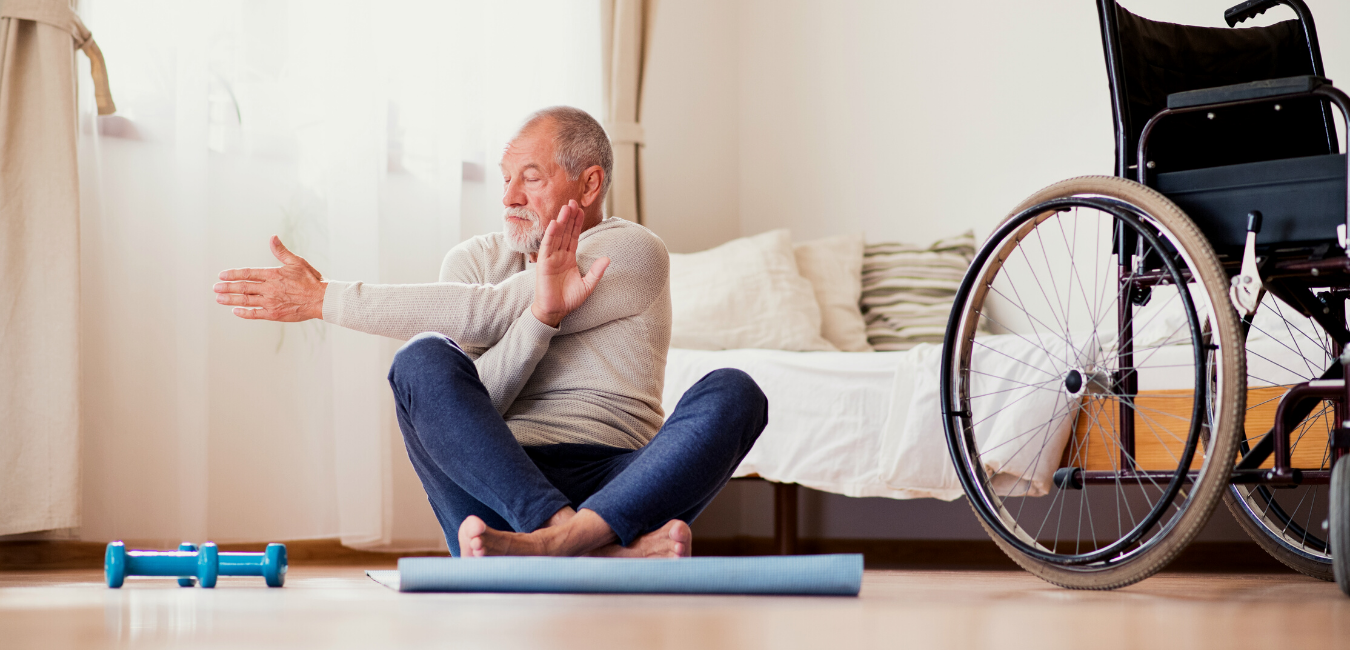Staying Active From Home

Being in isolation or even minimizing our usual social interactions during COVID-19 has seen many of us less physically active than we would usually be. Here are a few ways you can increase your activity from home.
Limited mobility doesn’t mean you can’t exercise
If you have limitations on your ability to move due to injury, disability, illness or other problem, you can still experience the benefits of exercise.
Exercise has a positive impact on your mood, relieves stress and anxiety, eases depression and improves your overall wellbeing. You may have experienced how inactivity has impacted your energy levels and mood. And today we want to highlight the importance of remaining active. Even mild to moderate exercise can impact your mental and emotional health significantly.
If you have a disability or are concerned about falls and injuries as you age, there are many options available to make exercise both safe and enjoyable!
What types of exercise are possible with limited mobility?
Keep in mind that some exercise is better than no exercise. The health benefits are well worth your investment in the time and energy it takes to find something that is suitable for you. Consider incorporating the following kinds of exercise into your week.
Exercises which raise the heart rate and increase endurance are known as cardiovascular exercise. With the guidance of your health professional find an activity you feel comfortable with. If walking is an option you might increase your pace and the length of your walk. Water aerobics, swimming and deep-water running are fantastic options as the water supports the body to reduce the risk of muscle or joint discomfort. If you are confined to a chair or wheelchair, it’s still possible to increase your cardiovascular health with chair aerobics or incorporating strength training exercises such as the use of weights and resistance exercises to build muscle. By adding weights or resistance training you will also increase your bone mass, improve balance and prevent injuries. If you have little or no use in your legs you can increase strength and heart rate by focusing on your upper body. Likewise, you can focus on strength training for your legs and core to improve overall body strength if your upper body cannot be exercised.
No matter your age or ability, range of motion is vital to preventing injury, reducing pain and maintaining a healthy body. Stretching exercises including yoga may be a perfect option for you.
Where do I start?
To begin to make healthy changes to your physical health, seek advice from your doctor or other medical professionals.
Ask the following:
What exercise do you recommend for me?
How often should I engage in this activity?
Are there any specific exercises I should avoid?
Is there a time of the day that is better for me to exercise when it comes to energy, medication and limitations?
Starting an exercise routine
Remember to ease into your new routine. Slow and steady is best. Go at your own pace and keep your mind focused on the benefits that will come day by day as you become more active.
Plan your day to include exercise
Plan ahead of time. Set your time, select what you will wear, have your water ready and any other accessories you require to accomplish your workout.
Give it time
It takes time for a new activity to become a habit. Tracking your exercise can be a great way to see how far you have come. Take note of your emotional health and if you notice any impact to your sleep patterns, weight and reduction in stress and anxiety. Once you notice these changes you will be even more motivated to continue exercising!
Make it fun
While your regular classes may be unavailable, see if you can access online classes, classes run live via Zoom or pre-recorded online on platforms such as YouTube or Vimeo. Exercise to your favourite music or exercise in space that makes you feel good. Outdoors, a favourite room, a deck or overlooking a beautiful garden will make the experience something you will look forward to. If possible, exercise with a friend.
Staying safe when exercising
If you feel any pain, dizziness, nausea, light-headedness or chest pain, stop immediately. If you continue to experience these symptoms speak with your medical professional. You may need to decrease the length and intensity of what you are doing.
Warm Up, stretch and cool down
Warming up the body gently before taking on more vigorous movements will protect you from injury or the pain that can follow exercise. As blood flows to your muscles and they warm up you will be ready to engage in your chosen activity with confidence that your body is ready! Stretching your muscles out after a workout will increase range of motion and minimize the aches that can follow a workout without thoroughly warming up and cooling down. Don’t stop abruptly but complete your exercise by slowing down your movements and their intensity gradually.
Stay hydrated
The benefits of staying hydrated are incredible! As your body moves your body will perform better when it is properly hydrated.
Focus on the positives
Concentrate on finding activities you enjoy and focus on what you can do, not what you can’t do.
Set a goal
As you build a routine, set yourself a goal you can work towards. Seeing improvement and accomplishing your goal will boost your self-esteem. Perhaps it could be the number of repetitions you do or how long you exercise for.
Celebrate!
Don’t forget to choose a way to celebrate your efforts. Your reward could be enjoying a favorite movie, purchasing a magazine, buying a new item of clothing or a nice piece of jewelry.

